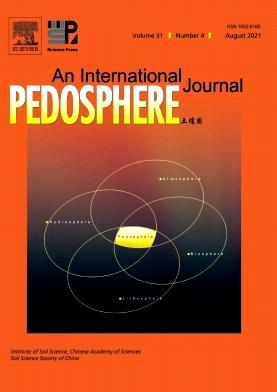Increased humic materials explain aggregate-protected carbon and nitrogen accumulation in biochar-amended tropical soils
IF 7.3
2区 农林科学
Q1 SOIL SCIENCE
引用次数: 0
Abstract
Humic materials make important contributions to soil organic carbon (C) and nitrogen (N) accumulation. However, information on the correlation between humic substances and the accumulation of soil aggregate-protected C and N in response to biochar application under tropical agroecosystems is limited. Therefore, a field trial was conducted to elucidate the effects of biochar on soil aggregate properties and humic materials and how these humic compounds affect aggregate-protected C and N in a humid tropical agroecosystem. The treatments included no-biochar control (CK), 15 Mg biochar ha-1 (BC-15), 30 Mg biochar ha-1 (BC-30), and 30 Mg biochar ha-1} + phosphate fertilizer (BC-30+P). The treatments BC-30 and BC-30+P significantly increased the contents of humic materials (humic and fulvic acids) as compared to CK. There was a significant increase in the mean-weight diameter of soil aggregates by 3- and 4-fold in BC-30 and BC-30+P, respectively. Similarly, BC-30 and BC-30+P led to significant increases in soil structural coefficient by 3- and 4-fold, respectively, relative to CK. Significant increases in organic C and N accumulation were observed in the macroaggregates of the biochar-amended soils. Inverse relationships between the degree of polymerization and aggregate-protected C and N were observed, implying that low-molecular-weight aliphatic compounds favor organic C and N accumulation with biochar amendments. The important soil property that contributed to organic C and N accumulation in aggregates was fulvic acid content, which could be used as an early and sensitive indicator to notice early changes in aggregate-protected C and N accumulation in soils of the humid tropics.
增加的腐殖质物质解释了生物炭修正的热带土壤中团聚体保护的碳和氮积累
腐殖质对土壤有机碳(C)和氮(N)积累有重要贡献。然而,在热带农业生态系统下,生物炭对腐殖质物质与土壤团聚体保护态C、N积累的相关性研究有限。因此,我们进行了一项田间试验,以阐明生物炭对土壤团聚体特性和腐殖质物质的影响,以及这些腐殖质化合物如何影响潮湿热带农业生态系统中保护团聚体的C和N。无生物炭对照(CK)、15 Mg生物炭ha-1 (BC-15)、30 Mg生物炭ha-1 (BC-30)和30 Mg生物炭ha-1 +磷肥(BC-30+P)处理。与对照相比,BC-30和BC-30+P处理显著提高了腐植酸和黄腐酸含量。BC-30和BC-30+P处理土壤团聚体的平均重径分别增加了3倍和4倍。BC-30和BC-30+P处理土壤结构系数较对照分别显著提高3倍和4倍。生物炭处理土壤大团聚体有机碳和氮积累显著增加。聚合程度与聚集体保护C和N呈反比关系,表明低分子量脂肪化合物有利于生物炭修饰的有机C和N积累。富里酸含量是影响团聚体中有机碳氮积累的重要土壤性状,可作为湿润热带土壤团聚体保护下碳氮积累早期变化的早期敏感指标。
本文章由计算机程序翻译,如有差异,请以英文原文为准。
求助全文
约1分钟内获得全文
求助全文
来源期刊

Pedosphere
环境科学-土壤科学
CiteScore
11.70
自引率
1.80%
发文量
147
审稿时长
5.0 months
期刊介绍:
PEDOSPHERE—a peer-reviewed international journal published bimonthly in English—welcomes submissions from scientists around the world under a broad scope of topics relevant to timely, high quality original research findings, especially up-to-date achievements and advances in the entire field of soil science studies dealing with environmental science, ecology, agriculture, bioscience, geoscience, forestry, etc. It publishes mainly original research articles as well as some reviews, mini reviews, short communications and special issues.
 求助内容:
求助内容: 应助结果提醒方式:
应助结果提醒方式:


